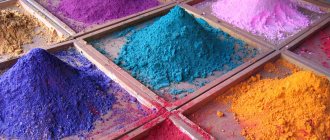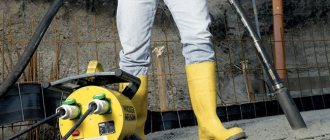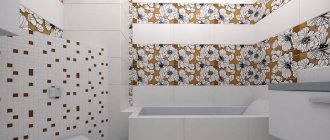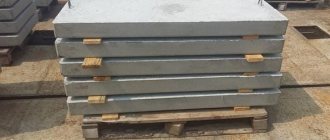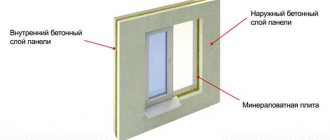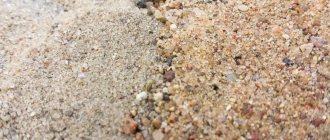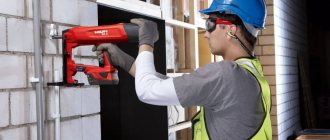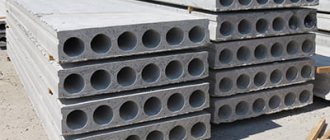Among the most important characteristics of a building under construction, the first place is the duration of construction and the amount of costs, 50% of which are the cost of materials. Costs can be significantly reduced through the use of modern construction technologies, for example, the construction of internal partitions from tongue-and-groove slabs. This wall material has long been appreciated by professionals in commercial construction. Those who build or repair their homes on their own are reluctant to use it, preferring brick, plasterboard frame structures, etc. As a result, time and money are spent inefficiently, since the market is overflowing with modern, inexpensive products, with which labor costs and the cost of work are reduced significantly! To help novice builders minimize costs, the editors of the Yanashla website offer a review of the best manufacturers of tongue-and-groove slabs for 2022, compiled according to the opinions of buyers and experts.
What types of tongue-and-groove slabs are there?
First you need to understand what it is and become familiar with the scope of use of this interesting building material.
Structurally, these are blocks, with grooves and ridges on the joining surfaces.
When constructing partitions, a tongue/groove connection is formed. Special compositions based on dry gypsum mixtures are used as masonry mortar. Some craftsmen use tile adhesive.
Important! Ready-made gypsum adhesive for laying GGP must be used within 60 minutes until it loses its mobility.
Depending on the composition, design and moisture resistance, the following types of blocks are distinguished:
- Plaster. Made from a mixture of building gypsum and plasticizing additives.
- Silicate. To make them, quartz sand, water, and quicklime are mixed.
- Full-bodied, i.e. monolithic without voids.
- Void. Monolithic surface and internal voids of various sections: round of various diameters or rectangular. Hollowness does not reduce the strength of products. They are lighter than full-bodied ones and easier to handle.
- Moisture-resistant, with water-repellent additives. Can be used in rooms with high humidity. 6. Ordinary, without water-repellent additives. For use only in dry rooms. When water gets in, they spread.
The cross-sectional shape of the groove/ridge forms a rectangle or trapezoid. Most often, manufacturers produce blocks of a standard size of 667x500 mm, with a thickness of 80 or 100 mm.
Some manufacturers produce products of reduced dimensions, for example, 495x248x80 mm. Such blocks have less mass and are easier to work with. But they also have a drawback - the absence of a groove/ridge on the horizontal joining surfaces.
Anatomy of the PGP or 5+1 important properties
The basis of the structure of partition elements is gypsum, which is a natural and environmentally friendly material. There are no restrictions on residential use. A convenient design solution - the presence of protrusions in the form of a ridge and a technological groove - guarantees reliable joining of individual products.
PGP has many unique qualities
In this case, the thickness of the seam is no more than 2-3 mm. Standard dimensions are 0.667 x 0.5 m, thickness 0.08 and 0.1 meters. GGP hollow tongue-and-groove slabs have a number of significant installation and operational characteristics. There are many of them, so we will consider the most important ones.
Helpful information! Possession of such a set of qualities automatically puts tongue-and-groove slabs into the class of leaders. According to experts, PGP are the favorites in the field of partition structures.
And now the indicator is codenamed “+1”. Technologists have developed and successfully used a solid tongue-and-groove gypsum slab with a weight of 27-32 kg. Further development of the PGP was achieved by a fantastic example in its manufacturability - a hollow slab. A design feature is the presence of voids. In full compliance with standards and basic characteristics, it weighs from 20 to 22 kg, which is 25% less than a full-bodied product.
Specifications
Before purchasing a PGP, consider the following characteristics:
Density
For gypsum products it is small, only 1350 kg/m3. However, this is enough to safely mount a china drawer or shelf on such a wall. The main thing is not to drill into the wall with a hammer drill or hit the dowel with a hammer. If you use self-tapping screws and a screwdriver correctly, there will be no problems. The density of silicate blocks is 1870 kg/m3.
Thermal conductivity
Manufacturers declare a thermal conductivity coefficient in the range from 0.040 to 0.045 W / (m°C). A good indicator that the material holds heat well. For the construction of internal self-supporting walls made of PGP, the use of heat insulators is not necessary.
Noise insulation
All manufacturers prescribe a noise insulation coefficient of 45-47 dB. However, do not delude yourself. When installing inter-apartment walls, an additional layer of sound insulation will not hurt at all.
Strength
Two characteristics are considered:
- the bending strength for gypsum panels usually does not exceed 2.5 MPa;
- for compression – no more than 5 MPa.
Silicate panels have a strength of M 150 or 15 MPa, i.e. they are three times stronger than plaster.
Vapor permeability
Conventional gypsum tongue-and-groove blocks have high vapor permeability. This explains their ability to absorb significant amounts of moisture. For moisture-resistant panels, this figure is reduced to a minimum. Gas silicate products also have minimal vapor permeability.
Preparatory work
List of tools for working with tongue-and-groove slabs:
The base for the wall made of tongue-and-groove slabs must be level, stable and completely free of dust. If the floor is concrete and there are differences in it exceeding 3 mm, then before starting installation work it is necessary to level it; create a leveling layer. For this purpose, a mortar based on sand and cement is suitable (grade of mortar is not lower than M50).
The solution is applied to a clean, damp floor. To obtain an ideal surface, you can create some kind of formwork and fill it with mortar precisely at a horizontal level. After complete drying, the base must be coated with a concrete primer.
If the partition is mounted on a wooden floor, then the base must be reinforced with a strong, even beam.
According to the technology, gypsum tongue-and-groove panels require a flat base - a screed or a separate non-sagging beam under the partition.
When the base is ready, you can mark the locations of partitions and doorways. This is done using lacing, a plumb line and a level.
Scope of application of tongue-and-groove slabs
GGPs are used in construction, renovation and redevelopment of apartments only for the construction of self-supporting structures. These include interior and apartment partitions. The latter are often made double, from blocks, 100 mm thick, with an air gap of 50 mm between them.
This technique improves the soundproofing and heat-insulating qualities of the structure. For the construction of permanent (load-bearing) walls, tongue-and-groove blocks are not strong enough and are not moisture resistant.
Pros and cons of using tongue-and-groove blocks for partitions
A partition serves to delimit space into rooms in a house or apartment, while it is not a protective barrier between the street and the living space. For this reason, thermal resistance takes a back seat, and more attention is paid to sound insulation and weight of the structure. Let's consider whether tongue-and-groove slabs meet these requirements.
Insulation of the PGP is possible in the case of a two-layer installation; in this case, a niche is formed between the two slabs where the heat insulator is placed.
Now we need to talk about the disadvantages that are important to consider before starting work.
Criteria for choosing tongue-and-groove slabs
The choice of one or another type of PGP depends on the purpose of the structure, the strength of its base, the expected load, dimensions, weight and cost of the product.
Moisture resistant
In rooms with high humidity, structures are erected from solid moisture-resistant slabs. They are easy to distinguish from ordinary ones because they have a greenish tint. Made from gypsum with water-repellent additives, they absorb moisture no more than 5% of their own volume.
The hygroscopicity of conventional gypsum products is about 26-32%. The difference is noticeable. Silicate GGPs are not divided into conventional and moisture-resistant, since their hygroscopicity is minimal. They are certainly suitable for use in bathrooms and bathrooms.
Regular
They are used to divide space between dry rooms: rooms and apartments. Use for separating bathrooms from the general space is permissible only with additional surface treatment with waterproofing and tiling.
Void
For interior structures, it is better to use hollow blocks, gypsum and silicate. They are lighter than full-bodied ones, by 25% (on average). They are easier to handle and easier to do when installing hidden electrical wiring. If the base is a plank floor on joists, it is better not to overload it. In this case, you should choose “voids”.
Full-bodied
Inter-apartment partitions are made of solid panels 100 mm thick. This design can also be made double by filling the gap with a roll of mineral wool-based material or leaving an air gap. If you are going to hang shelves for dishes or books on the wall, it is better to choose solid products. Gypsum is easier to drill, silicate is more durable. The use of plastic dowels for screwing in self-tapping screws is mandatory in both cases.
Silicate
They differ from gypsum in their smaller size, greater strength and the absence of grooves and ridges on horizontal joining surfaces. On the one hand, they are more convenient to work with (less weight and dimensions), on the other hand, the absence of a “ridge/groove” connection in the horizontal plane complicates the work, forcing the master to constantly ensure that the blocks fit in the same plane (do not “wiggle”) . But hanging shelves on structures made of silicate PGP does not cause any difficulties.
Types and features of material
Tongue and tongue slabs vary in size, design and material. They are a solid slab with cutouts (grooves) on one side and tongues (ridges) on the other.
Dimensions
By design
Massive, high-density material provides better protection from low frequencies. Structures with air layers inside and porous structures work better against high-frequency noise.
Full-bodied ones are heavier and stronger, they provide better sound insulation from low frequencies. They are used in cases where increased rigidity is required from the wall. Solid slabs have higher fastener retention strength, so they are used for hanging heavy objects.
By thickness
By material
What to pay attention to
First of all, the weight of the panel. Products of the same dimensions and type from different manufacturers may differ in weight. A solid standard panel from Knauf or Magma weighs 28 kg, and the same one from Aksolit or the Peshelan plant weighs all 35. It is clear that lighter products should be chosen.
Gypsum panels are a “delicate” material. It must be transported and stored carefully, otherwise you will not be able to avoid chips and cracks. PGP differ from brick in that it has a smooth surface that does not require leveling before painting or wallpapering. A finishing operation such as plastering is no longer necessary. It is enough to putty the joints and apply a thin layer of finishing putty. If improperly transported or stored, gypsum panels may develop broken corners and edges, chips on the surface, broken ridges and broken grooves. All this will have to be puttied and leveled.
Installation of elastic gasket
To ensure that temperature changes and deformation of the load-bearing elements of the building do not lead to the destruction of the partition over time, the structure made of PGP should be isolated from the base and adjacent walls with a special elastic (damper) tape. Damper tape for PGP protects the wall from mechanical damage and increases the soundproofing qualities of the partition. The elastic tape is a special cork backing (at least 75 mm wide), which we will glue to the base and walls in accordance with the markings made. The boards and tape are fixed with the same mounting adhesive.
Apply a thin layer of glue to the prepared surface using a spatula. The tape is rolled out from above and pressed lightly with your hands. The glue sets within one hour. After this period, you can begin building the partition.
Technology for constructing partitions from PGP
Before starting work, you should make sure that the base under the wall is perfectly level, with zero slopes. Even small differences in the height of the base will cause a crack to form in the structure. For better sound insulation, a damper tape made of foamed polyethylene is placed under the first row. It is also laid at the junction points between the PGP and the main wall.
As in a brick partition, tongue-and-groove panels are laid with a bandage. The combination of vertical seams is unacceptable.
The products are easily cut with a reciprocating saw or a hand hacksaw for wood. It is not difficult to dissolve one or several pieces. If you have to do a large amount of work in an apartment building, you can’t cut much with a hacksaw, your hands will fall off. The process needs to be mechanized.
On a note! During repairs with redevelopment, with a large volume of work, you can cut blocks with a grinder with a diamond wheel. The process is accompanied by the formation of a large amount of dust and is best performed outdoors. This is one of the disadvantages of using gypsum products.
For laying blocks, special adhesive compositions are used as a solution, which are produced by most companies that have launched the production of PGP. Wholesale and retail sales always include tongue-and-groove panels and glue for them from one manufacturer.
To connect to the main wall, metal corners and self-tapping screws are used. To give the structure greater rigidity, adjacent PGPs are connected to each other with metal plates, laying them through two panels.
The installation locations of door blocks are not covered with lintels if the opening width does not exceed 900 mm. A gap of 20-30 mm is left between the partition and the ceiling. It can be sealed with the same masonry mortar or polyurethane foam.
Features of installation of communications
A partition installed from tongue-and-groove slabs may need sockets or lamps. In order to hide the wiring, grooves are made with a hacksaw, jigsaw or wall chaser. It is better to avoid laying electrical wiring channels and other communications with a hammer drill. It is difficult to make even grooves with it. You can use a grinder, but during the work there will be a lot of dust. In such situations, they use a construction vacuum cleaner together with an angle grinder or opt for a hand tool.
Strobe in a gypsum board for a socket
Hollow tongue-and-groove slabs are convenient for wiring installation. The wires are pulled through the empty tubular channels of the slabs.
When choosing tongue-and-groove gypsum boards, we recommend purchasing materials from trusted manufacturers. Our assortment includes materials from Knauf and Volma companies. These manufacturers have full certification for their products, which undergo the necessary tests.
The best manufacturers
- Knauf
The company was founded by the Knauf brothers, mining engineers, in 1932. The company's first products were dry construction mixtures. The production of plasterboard sheets began in 1958. At the end of the 70s, a representative office of the company was opened in the USSR. Today, the international group of companies Knauf is the largest investor in the construction industry in the CIS countries. The popularity of Knauf models is explained by their consistently high quality.
- Magma
Republic of Mordovia, group. One of the largest suppliers of dry building mixtures, plasterboard panels and tongue-and-groove blocks. The production lines are equipped with the latest German equipment.
- Gypsum polymer
The pride of the Perm region, one of the largest producers of dry building mixtures and gypsum building materials. Founded in 1953. It produced dry gypsum plaster, an analogue of gypsum board. It received its current name after corporatization in 1993. The GGP production line was launched in 2013. The company's inexpensive products are in constant demand among builders.
- ECO
Yaroslavl company. On the market since 2004. The main specialization is reinforced concrete elements and piles. The enterprise is equipped with modern Spanish equipment. The silicate hollow products are produced on a production line supplied by the German company Wehrhahn.”
- Forman
The brand belongs to the Samara Gypsum Plant. The company produced its first batch of construction gypsum in 1944, and soon occupied a leading position in the industry. In 2013, the company begins production of European-standard PGP at the facilities of a new plant equipped with the most modern equipment of the German company Grenzebach Gmbh.
- Volma
In 1943, construction of a gypsum plant began in Stalingrad. The destroyed city needed to be restored, and there was a catastrophic shortage of building materials. Before the start of perestroika, the enterprise developed dynamically, becoming one of the largest in the construction industry of the USSR. During perestroika, production fell steadily and almost completely stopped. With a change of owner, in 1999 the company was revived under the new name “Volma”.
A new life began with the development of the production of plasterboard sheets. Two years later, the production of dry construction mixtures was added to this, and since 2003, the production of tongue-and-groove slabs. Today, the company's factories produce products in Volgograd, Voskresensk, Chelyabinsk, Orenburg, as well as in Tatarstan, Adygea, and the Republic of Belarus. Popular Volma models are in high demand in the domestic construction market.
- KZSM
Kaluga building materials plant. Operating since 2000. KZSM budget products are of high quality, confirmed by relevant certificates.
- MAZD
The Moscow Magistral plant of large-panel partitions has existed for more than 50 years. MAZD units are produced using equipment supplied by the Italian company.
- Axolit LLC
A young enterprise for the production of building materials from gypsum. Production facilities became operational in 2013. The company specializes in plasterboard sheets, tongue-and-groove panels, and dry gypsum-based building mixtures.
The list of enterprises can be continued for a long time. Dimensions, assortment, technical characteristics of panels from different manufacturers differ little from each other. So the choice of manufacturer has to be determined more by the price of the products.
Attachment Mounts
Wall-mounted furniture is attached to the plaster partition using universal plastic dowels. The main difference between universal dowels is that when they get into a cavity, they are able to twist, providing reliable fastening in this position even with large load-bearing loads.
To fasten heavy plumbing fixtures, use universal plastic dowels and stud screws. If the partition is double, then the best option for attaching plumbing fixtures is through spring dowels.
Chemical anchors are also suitable for heavy structures.
Where to buy tongue-and-groove slabs
The easiest way is to make a purchase at your nearest building materials store. Delivery from afar may cost more than the products themselves. Most stores and wholesale suppliers have their own online resources that allow you to order PGP online. The same can be done in an online store if the supplier’s base is located nearby. Before purchasing, you should listen to the advice and recommendations of professional builders regarding the quality of products from a particular supplier, clarify how much it costs and determine the required quantity of goods, taking into account waste. On the manufacturer's website you can find a calculator that makes it easier to make all the calculations.
Fastening the partition to the wall
The strength of the connection of the tongue-and-groove partition to the walls and base is ensured by the installation of additional elements: mounting angles, fittings or hangers. It is more convenient to use mounting angles or hangers. After all, they are attached to the slab using ordinary self-tapping screws, and to the walls using dowels. The slabs of the 1st, 3rd, and 5th rows are attached to the side walls. It is possible more often, but there must be several (at least three) fastenings. A strong base connection is created for every second slab.
During installation, direct hangers can be installed directly into the groove of the slab, having previously cut them to the required dimensions.
Between the top row of masonry and the ceiling of the room you will need a technological gap of at least 1.5 cm. It must be left and foamed with polyurethane foam. After drying, excess foam must be cut off and the seam must be puttied. Between the top row and the ceiling, additional fasteners are installed at the same frequency as below.
Rating of high-quality tongue-and-groove slabs
KZSM
The review opens with the products of the Kaluga building materials plant - a solid gas silicate tongue-and-groove block. The height of the blocks is 280 mm, length – 248, thickness – 80 mm, weight 18 kg. It differs from most tongue-and-groove panels in its smaller dimensions and weight, which makes it more convenient for work. That's a plus. But there is also a minus - the absence of grooves and ridges on horizontal planes. Sound insulation rates are high, ranging from 48 to 52 dB. An excellent budget option.
tongue-and-groove slab KZSM
Advantages:
- low thermal conductivity;
- good sound insulator;
- affordable price.
Flaws:
- absence of groove and ridge on the horizontal plane of the block.
| Model name/country manufacturer | Characteristics | average price |
| KZSM / Russia, Kaluga | Solid tongue-and-groove silicate block. Sound insulation - 47 dB, thermal conductivity coefficient - 0.045 W/m°C. Dimensions 495x248x80mm. Weight - 18 kg. Consumption 8 blocks per sq.m. | 58 rubles |
Gypsum polymer GGP
The hollow moisture-resistant Perm panel has dimensions standard for this wall material: 667x500x80mm. Rectangular grooves and ridges. The strength indicators are not bad for a gypsum panel, but the weight of 29 kg exceeds the weight of hollow products of the same size from other manufacturers. Used in dry and normal humidity areas.
tongue-and-groove slab Gypsum polymer GGP
Advantages:
- ease of installation;
- low cost;
- the smooth surface does not require leveling before finishing.
Flaws:
- heavy weight.
| Model name/country manufacturer | Characteristics | average price |
| Gypsum polymer GGP / Russia, Perm | Hollow, white, area 0.33 sq.m. Withstands loads of no more than 5.0 MPa in compression, no more than 2.5 MPa in bending, with a density of 1250 kg/cub.m. Dimensions 667x500x80mm. Weight - 29 kg. | 145 rubles |
Peshelan
The slabs of the Peshelansky gypsum plant (Nizhny Novgorod region) have standard dimensions and weight 36 kg. They are used in the construction of partitions in dry residential and office buildings. The presence of rectangular grooves and ridges greatly facilitates the construction of self-supporting structures, but the weight of each block exceeds two pounds. You cannot handle a large volume of masonry alone, especially starting from the third or fourth rows. The smooth surface of the slabs allows you to significantly reduce the amount of pre-treatment of walls before finishing.
tongue-and-groove slab Peshelan
Advantages:
- smooth and even surface;
- affordable price.
Flaws:
- heavy weight of the slab;
- low strength.
| Model name/country manufacturer | Characteristics | average price |
| GGP standard Peshelan / Russian Federation, Republic of Mordovia | Full-bodied, white, area 0.33 sq.m. Dimensions 667x500x80mm. Weight - 36 kg. Compressive strength - 3.5 MPa, bending strength - 1.7 MPa. | 179 rubles |
Magma
Full-bodied, water-resistant, standard size, 28 kg, with rectangular grooves and ridges. Easy to install. Can be used in rooms with high humidity. The average cost of one piece is 220 rubles. For one square meter of partition (three pieces), the buyer will pay 660 rubles (excluding delivery costs). Good value for money.
tongue-and-groove slab Magma
Advantages:
- waterproof;
- relatively light;
- smooth flat surface.
Flaws:
- not identified.
| Model name/country manufacturer | Characteristics | average price |
| Magma / Russian Federation, Republic of Mordovia | Full-bodied, moisture-resistant, with an area of 0.33 sq.m. Dimensions 667x500x80mm. Weight - 28 kg. | 220 rubles |
M-150 Eco
M-150 silicate panels are characterized by reduced (compared to standard) dimensions and weight. They are easier to install, more durable and moisture-resistant compared to gypsum wall materials. The absence of grooves and ridges in the horizontal plane requires a certain level of skill from masons. To build a 1.0 m2 partition you will need 8 pieces. With the cost of one panel being 95 rubles, one square meter of such a wall will cost 744 rubles.
tongue-and-groove plate M-150 Eco
Advantages:
- relatively small dimensions and weight;
- strength;
- moisture resistance.
Flaws:
- absence of grooves and ridges in the horizontal plane.
| Model name/country manufacturer | Characteristics | average price |
| M-150 ECO / Russia | Silicate hollow, moisture resistant, area 0.123 sq.m. Dimensions 498x248x70mm. Weight 12 kg. | 93 rubles |
Forman
Hollow moisture-resistant standard, weighing 22 kg. It is used for constructing self-supporting wall enclosures in dry and wet rooms. Relatively light weight allows you to perform a large volume of work in one shift. The flat and smooth surface of the products does not require additional leveling before wallpapering or painting. The average price per piece is 195 rubles. The cost of one square meter of partition (three pieces) will be 585 rubles (not counting the cost of glue, fasteners, transportation and labor).
tongue-and-groove slab Forman
Advantages:
- European quality;
- low thermal conductivity;
- high degree of sound insulation;
- affordable price.
Flaws:
- not identified.
| Model name/country manufacturer | Characteristics | average price |
| Forman / Russia, Samara | Tongue-and-groove hollow, moisture-resistant, green, with an area of 0.33 sq.m. Dimensions 667x500x80mm. Weight - 22 kg. | 195 rubles |
Aksolit
Axolit produces regular and moisture-resistant PGP, hollow and solid, standard sizes 667x500x80mm. Our review examines a solid moisture-resistant slab. This is a fairly strong gypsum product; when tested for bending strength, it can withstand a load of 2.5 MPa. Thermal conductivity is high - 0.208 W/(m°C). When constructing interior structures, thermal insulation will be required. The average price of one piece is 210 rubles. For 1.0 m2 (three pieces) you will have to pay 660 rubles. This is somewhat more expensive than previous samples.
tongue-and-groove slab Aksolit
Advantages:
- ease of installation;
- smooth surface;
- moisture resistance.
Flaws:
- weight of one panel is 35.2 kg.
| Model name/country manufacturer | Characteristics | average price |
| Aksolit / Russia | Full-bodied tongue-and-groove slab, moisture-resistant, green, with an area of 0.33 sq.m. Dimensions 667x500x80mm. Weight - 35.2 kg. Thermal conductivity 0.208 W/m°C. | 210 rubles |
MAZD 80
Hollow waterproof panels are made from a mixture of gypsum, cement and pozzolanic additives and have dimensions of 700x358x80 mm. The weight of each product is 16 kg. The grooves and ridges are trapezoidal in shape and are not compatible with wall materials from other manufacturers. With the cost of one piece being 127 rubles, the cost of 1.0 m2 of partition will cost only 508 rubles. Excellent value for money and quality.
tongue-and-groove plate MAZD 80
Advantages:
- European quality;
- convenient sizes for work;
- light weight;
- affordable price.
Flaws:
- not identified.
| Model name/country manufacturer | Characteristics | average price |
| MAZD 80/ Russia, Moscow | Hollow tongue-and-groove slab (40%), moisture-resistant, area 0.25 sq.m. Sound insulation - 35 dB. Density no more than 1100 kg/cub.m. Dimensions 700x358x80mm. Weight - 16 kg. In 1 sq.m. - 4 things. | 127 rubles |
PGP Volma
Volma's PGP products are distinguished by their high quality and affordable price. Our review presents hollow moisture-resistant slabs of a standard size, weighing 22 kg, with an average price of 190 rubles per piece. For 1.0 m2 of high-quality, lightweight material for the construction of partitions, the buyer will pay only 585 rubles.
tongue-and-groove slab PGP Volma
Advantages:
- moisture resistance;
- high-quality surface;
- affordable price;
- relatively light weight of the plate.
Flaws:
- not identified.
| Model name/country manufacturer | Characteristics | average price |
| Volma Voskresensk / Russia | Hollow tongue-and-groove slab, moisture-resistant, green, with an area of 0.33 sq.m. Dimensions 667x500x80mm. Weight - 22 kg. | 190 rubles |
Advantages of using hollow core slabs
Tongue-and-groove slabs have a convenient connection
Compared to its monolithic brother, the “void” can be proud of its capabilities.
Important! Fastening of suspended structures on walls made of hollow tongue-and-groove slabs is carried out using dowels and special type anchors, working on the “butterfly” principle.
Thus, if a reputable developer is planning an economical approach to the construction process, then the use of hollow tongue-and-groove slabs will significantly reduce overall costs. This decision is also justified by the technical indicators of the “emptiness”.
Do you want to buy tongue-and-groove slabs from famous brands at the best price? The time to do this is now!
Source
Comparisons with solid slabs
In addition to hollow slabs, another type of tongue-and-groove construction is presented on the construction market - solid slabs. Many inexperienced consumers are wondering what the difference is between these building materials, and which tongue-and-groove ridge is better, what to give preference to.
Hollow and solid tongue-and-groove slabs differ in several parameters.
- By weight. A hollow slab is much lighter. This is due to the design features, namely the presence of voids inside the product.
- Base load factor.
- Permissible load that the structure can withstand. In this case, of course, solid slabs are in the lead.
There are still more similarities between these types of building materials:
- sound insulation level;
- strength;
- shape and size.
And also the slabs are identical in the method of fastening along the butt edge.
Preparing for wallpapering
Preparing the partition for wallpapering comes down to cleaning the seams, leveling and priming the surface. If scratches or scratches appear on the wall during the installation of tongue-and-groove slabs, they should be repaired with putty before applying the primer.
You can discuss the advantages and disadvantages of materials used for the construction of wall partitions in the corresponding FORUMHOUSE section. If you are looking for fresh solutions for quickly building walls, pay attention to the article about houses made of wood concrete panels. A master class on the construction of partitions from gas silicate blocks will introduce you to all the intricacies of this construction technology.
Source
Advantages of blocks
They are valued for their ease of installation and speed of construction. Reduced labor intensity of operations and low load on the base are their main advantages over other materials.
Performance characteristics:
- The ability of gypsum boards to “breathe” plus the absence of toxic fumes. Good sound insulation of rooms, especially if installation is carried out “in two walls”. Almost ideal front surface, ready for finishing. Fire safety - belongs to the NG group.
The compressive load that a standard gypsum board holds can be equated to strength grade M35, moisture-resistant ones are stronger - they already have an index of M50.
What is better for partitions: foam block or PGP?
The answer depends on several factors:
1. Do you plan to subsequently mount heavy attachments to the wall?
In gypsum PGP, hardware will hold better and more reliably than in porous blocks. These are destroyed under concentrated load unless a special type of fastening is selected. Tongue-and-groove slabs made of building gypsum are designed for no more than 200 kg.
2. How important it is to preserve the maximum usable space in a partitioned room. Profiled panels, due to their smaller sizes, do not “steal” the area as much as foam block masonry with a thickness of 20-30 mm.
3.
Humidity conditions. If you need to build internal partitions in rooms where exposure to water or saturated steam is high (bathhouse, bathroom), it is better not to take risks, but to use foam blocks. Green gypsum panels will also cope with the task, but here you need to compare the cost of such construction.
In terms of speed of construction, the tongue-and-groove partition slab is unrivaled. The inner wall grows in just a couple of hours.
Application
Internal partitions made of tongue-and-groove blocks are the first thing that begins to be erected after the completion of the main stages of construction.
The walls are traditionally built up even before the finishing floors are laid. The use of GWP also comes in handy when remodeling premises. Thanks to the large area of the side surfaces and ease of installation, work proceeds quickly, without loss of quality and time for rough finishing.
It is quite possible to install internal walls from a double layer of PGP - this allows for hidden installation of communications in the void between two planes. If it is necessary to minimize the permeability of sounds from neighboring rooms, this method of masonry can also be used. But to preserve the usable area, it is better to choose hollow-core products with a thickness of 100 mm.
Installation Tips
To make installation of the PGP simple and convenient, it is necessary to carefully prepare the base under the future wall. It must be perfectly smooth and level. If increased sound protection requirements are imposed on the partitions, a gasket made of cork should be additionally secured to the main wall.
The tongue-and-groove coupling is not yet a guarantee of the reliability of masonry made from narrow panels, so partitions are not installed without the use of glue. Experts recommend using different compositions for each brand of slabs. For example:
- The Knauf tongue-and-groove block is combined with adhesives of the same brand Perfix and Knauf Fugenfüller. Volma-Shov or Montazh mixtures are suitable for Volma.
The adhesives contain gypsum, quartz sand of the finest fraction and mineral additives that provide mechanical strength to the seams. Because of them, the mixture sets faster - within 10-15 minutes, then there will be no time to correct the flaws. It is recommended to additionally treat moisture-resistant panels at the joints with silicone sealant.
